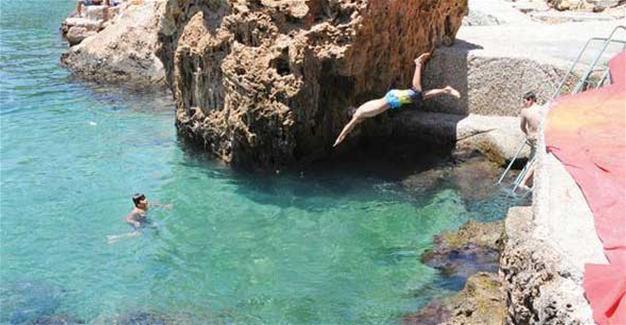500 critically injured, killed each year in Turkey after diving headfirst into shallow waters
Mesude Erşan - ISTANBUL

Some 500 people each year in Turkey break their necks, either dying of respiratory failure instantly or suffering spinal cord injury and mostly becoming wheelchair-bound as a result of diving headfirst into shallow waters, with the figures reaching thousands of people when added with world figures.
The Turkish Neurosurgical Society’s head, Yusuf Şükrü Çağlar, warned swimmers not to dive headfirst if they are not sure of the depth of the water or in places with water depths less than two meters.
“If the depth of the water cannot be seen, plunging headfirst should not be done. However well one jumps, a serious injury can be incurred,” he said.
“You may know how to swim, but the water can be deceptive. The water that seems deep to you, can in fact be shallow,” Çağlar added.
If the swimmer incurs a neck injury, their neural system controlling the movement of arms and legs as well as the one regulating the respiratory system is affected, which can result in the person getting paralyzed or even dying, according to Çağlar.
“In such accidents, the cervical [neck] spinal cord, our most precious organ, gets sheared by the crashed backbone due to the fracture or can lose its functioning capability due to compression. A wrongly conducted first aid in spinal cord accidents does not only increase the damage on the victims but only can lead to their deaths,” Çağlar said.
Diving headfirst is the fourth leading cause of spinal cord injuries, and the average age of those getting injured is between 20 and 29, with most of them being males.
As a result of warning signs placed on seashores in the U.S. and Australia, accidents caused by diving headfirst decreased by some 70 percent. “Although 28 provinces in Turkey have a coastline, unfortunately, except Istanbul, there is not even one warning sign in other provinces. Before each summer, every province’s health authority needs to provide informative boards in an attention-grabbing way by coasts and swimming pools, under the name of schools and social awareness projects,” he added.
Kadir Kotil, the Turkish Neurosurgical Society’s spinal and peripheral neurosurgery group’s head, on the other hand gave suggestions on what one should do if they ever come across an injury incurred from headfirst diving.
He said they should first call the emergency services by dialing the common emergency phone line 112. Then, they should keep the victim’s neck still for as long as possible. For the victim to breathe properly, they should be tilted on their side to help the lungs drain out the water.
“A malformation on the patient’s neck should not be corrected. All of their neck vertebrae may be broken. If the spinal cord has not yet suffered a damage, an inappropriate position the neck is put in during the first aid to the patient can make the broken bone pieces to put pressure on the spinal cord and thereby cut it and damage it,” Kotil warned.
 Some 500 people each year in Turkey break their necks, either dying of respiratory failure instantly or suffering spinal cord injury and mostly becoming wheelchair-bound as a result of diving headfirst into shallow waters, with the figures reaching thousands of people when added with world figures.
Some 500 people each year in Turkey break their necks, either dying of respiratory failure instantly or suffering spinal cord injury and mostly becoming wheelchair-bound as a result of diving headfirst into shallow waters, with the figures reaching thousands of people when added with world figures.